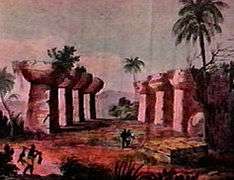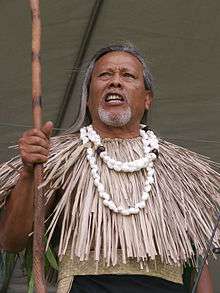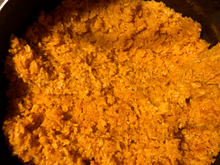Chamorro people
 Chamorro people (1915) | |
| Total population | |
|---|---|
| 147,798 (2010 census)[1] | |
| Regions with significant populations | |
|
| |
| 59,381 (2010 census)[2] | |
| 12,902 (2010 census)[3] | |
| (2010 census) | |
| (2010 census) | |
| Languages | |
| Chamorro (Native language), English (Official language), Japanese, Spanish | |
| Religion | |
| Christianity (mostly Roman Catholic) | |
| Related ethnic groups | |
| Other Austronesian peoples and peoples of Micronesia | |
The Chamorro people (/tʃɑˈmɔroʊ/)[4] are the indigenous people of the Mariana Islands; politically divided between the United States territory of Guam and the Commonwealth of the Northern Mariana Islands in Micronesia. Today, significant Chamorro populations also exist in several U.S. states including Hawaii, California, Washington, Texas, Tennessee, Oregon, and Nevada. According to the 2000 Census, approximately 65,000 people of Chamorro ancestry live on Guam and another 19,000 live in the Northern Marianas.[5] Another 93,000 live outside the Marianas in Hawaii and the West Coast of the United States. The Chamorros are primarily Austronesian, but many also have European (Spanish) and East Asian ancestry.
Language
The Chamorro language is included in the Malayo-Polynesian subgroup of the Austronesian family. Because Guam was colonized by Spain for over 300 years, Chamorro has acquired many loanwords from Spanish. An example is how the traditional Chamorro number system was replaced by Spanish numbers.[6]
Chamorro is often spoken in many homes, but this is becoming less common. However, there has been a resurgence of interest in reviving the language, and all public schools on both Guam and the Northern Marianas are now required by law to teach the Chamorro language as part of the elementary, middle, and high school curriculum.
The most spoken phrase in Chamorro is Håfa Adai or Håfa Dai, a greeting which approximates “Hello” in English.
Early Chamorros
The Chamorro are commonly believed to have arrived in the Marianas Islands from Southeast Asia circa 2,000 BC. They are most closely related to other Austronesian-speaking natives in eastern Indonesia (specifically in Maluku and Sulawesi), Taiwanese aborigines, as well as peoples of the Caroline Islands to the south (in particular the outer islands of the FSM state of Yap). They were expert seafarers and skilled craftspeople familiar with intricate weaving and detailed pottery-making. The latte stone, a megalithic rock pillar topped with a hemispherical capstone, was used by early Chamorros as foundation for buildings and has since been appropriated as a national symbol.
Chamorro society was based on what sociologist Dr. Lawrence J. Cunningham termed the “matrilineal avuncuclan”, one characteristic of which is that the brother(s) of the female parent plays a more primary paternal role than biological male parent of a child.[7][8]
Agriculture
Spanish colonial records show that Chamorro farmers planted seeds according to the phases of the Moon. For example, farmers on Guam often plant tuber crops such as sweet potato and yams at full moon during low tide.[9]
Culture
Cosmogony and religion

According to early Chamorro legend, the world was created by a twin brother and sister, Puntan and Fu'uña.[10] As he lay dying, Puntan instructed his sister Fu'uña to make his body into the ingredients of the universe. She used his eyes to create the Sun and Moon, his eyebrows to make rainbows, and most of the rest of his parts into various features of the Earth. Once her work was complete, she descended on an island called Guåhan (Guam), and transformed herself into a giant rock. This rock split, and from it emerged all human beings. Some believe that this rock was once located at the site of a church in Agat, while others believe it is the phallic-shaped Laso de Fua located in Fouha Bay in Umatac.
Ancient Chamorros engaged in ancestor veneration, but did not practice a formal "religion”" in the sense of worshiping deities. However, there is at least one account by Christoph Carl Fernberger in 1623, that human sacrifice was practiced to placate a "great fish". This claim may be related to a Chamorro legend about why the island of Guam is narrow in the middle. According to the legend, a gigantic fish was gradually eating away at the island from both sides. Although the ancient Chamoru supposedly had magical abilities, the huge creature eluded them. When the men were unsuccessful in hunting it down, the women used their hair to weave a net, which grew larger as they sang. The singing enchanted the fish, and lured it into the giant net.[11]
Castes and classes

Chamorro society was divided into two main castes, and continued to be so for well over a century after the Spanish first arrived. According to historical records provided by Europeans such as Father Charles Le Gobien, there appeared to be racial differences between the subservient Manachang caste, and the higher Chamor[r]i, the Manachang being described as shorter, darker-skinned, and physically less hardy than the Chamori. The Chamori caste was further subdivided into the upper-middle class Achoti/Acha'ot and the highest, the ruling Matua/Matao class. Achoti could gain status as Matua, and Matua could be reduced to Achoti, but Manachang were born and died as such and had no recourse to improve their station. Members of the Manachang and the Chamori were not permitted to intermingle. All three classes performed physical labor, but had specifically different duties.[12][13] Le Gobien theorized that Chamorro society comprised the geographical convergence of peoples of different ethnic origins. This idea may be supportable by the evidence of linguistic characteristics of the Chamorro language and social customs.
Father Pierre Coomans wrote of the practice among Chamorro women of teeth blackening/dental lacquering (also a widespread custom in ancient maritime Southeast Asia, Japan, southeastern China, and parts of Indochina), which they considered beautiful as a distinction apart from animals.[14] Fernberger wrote in his account of the Chamorro that “penis pins” were employed as a chastity measure for young males, a type of genital piercing similar to those employed by inhabitants of precolonial Maritime Southeast Asia.[15]
Folklore
Traditional beliefs among the Chamorro include tales of taotaomo'na and birak, as well as the Spanish-introduced concepts of duendes and hauntings in places such as in Yona, other old buildings, schools, hotel elevators, and the Ma’ina bridge.[16] Taotaomo'na are spirits of ancient Chamorros. Birak is a broader term that may refer not only to the undead, but also to demons or general elemental types.
Foreign rule
On March 6, 1521 Ferdinand Magellan and his men had after having crossed the Pacific Ocean encountered the first "indios" since leaving South America.[17] Later Spanish visitors named the inhabitants "Chamurres", derived from a local term for the upper caste; this was then converted to "Chamorros", an old Spanish term for "bald", perhaps in reference to the local habit to shave.[17]
Over the centuries, the Mariana Islands have been occupied by several foreign countries (Spain, Germany, Japan, United States), and present-day Chamoru society is almost entirely multiethnic, with the inhabitants of Luta/Rota being the least so. The Chamoru are primarily of Austronesian ancestry, but began to significantly interact with Spanish and Filipinos during the Spanish Colonial Era (1521–1898 AD). Primarily since the late 19th century onward, many Chamorus have intermarried with other Pacific Islanders, mainland Americans, Filipinos, Chinese, and Japanese.
During the Spanish Colonial Era, the Chamoru population was greatly reduced by the introduction of European diseases and changes in society as well as all out war under Spanish rule. The Spanish killed many Chamoru men and relocated most others to Guam, where they lived in several parishes to prevent rebellion. Some estimate that as many as 100,000 Chamorus may have populated the Marianas when Europeans first settled in 1667. By 1800, there were under 1,000. Within the parishes, the Spanish eventually focused their efforts on converting the natives to Catholicism. Father Frances X. Hezel stated that Chamorus caught or reported engaging in pagan "sorcery" were publicly punished. Through this, they were given Spanish surnames through Catálogo Alfabético de Apellidos or Alphabetic Catalog of Surnames. Thus, a multiracially mixed Chamorro with European descent and a Spanish surname may not necessarily have Spanish blood, any more than Filipinos with Spanish surnames do.
Because the Marianas are a part of the United States, the Chamoru people enjoy greater economic opportunities than many other Micronesian peoples. The increasing numbers of Chamorus, especially Chamoru youth, relocating to the U.S. Mainland, has further complicated both definition and preservation of Chamoru identity. On Guam a Chamoru rights movement has developed since the United States gained control of the island. Leaders of the movement seek to return ancestral lands to the Chamoru people, and attain self-determination.
"Chamorro" and "Chamoru"
Pre-colonial society in the Marianas was based on a caste system, "Chamori" being the name of the ruling, highest caste.[12]
After Spain annexed and conquered the Marianas, the caste system eventually became extinct under Spanish rule, and all of the indigenous residents of the archipelago eventually came to be referred to by the Spanish exonym "Chamorro". The name "Chamoru" is an endonym derived from the indigenous pronunciation of the Spanish exonym.
Some people theorize that Spanish definitions of the word "Chamorro" played a role in its being used to refer to the island's indigenous inhabitants. Apart from "Chamorro" being a Spanish surname, in Spanish it also means "leg of pork", "beardless [wheat]", "bald", "close-cropped", or "shorn/shaven/[hair or wool] cut close to the surface".[18][19][20] Circa 1670, a Catholic missionary reported that men were sporting a style in which their heads were shaven, save for a "finger-length" amount of hair at the crown. This hairstyle has often been portrayed in modern-day depictions of early Chamorros. However, the first European descriptions of the physical appearance of the Chamoru people in the 1520s and 30s report that both sexes had long black hair which they wore down to their waists or even further. Another description, given about 50 years later, reported that the natives at that time were tying up their hair into one or two topknots.[14]
Modern Chamorro culture
Chamorro culture has over the years acquired noticeable influences from Spanish, Mexican, American, Japanese and Filipino cultures, as well as the presence of fellow Oceanic (mostly Micronesian) groups. Influence from the German era in the Northern Marianas is most visible in the form of certain given names and family surnames.
The prehistoric concept of inafa'maolek ("doing good for each other", often translated as interdependence) is a core value of traditional Chamoru culture. Respect for one's family, community, and the elderly (man åmko') are major components, although this varies from person to person and family to family. The culture is now strongly influenced by American customs and values, largely because the Marianas archipelago (partitioned into Guam and the CNMI) is currently possessed by the United States of America, as organized but unincorporated territories; in addition, most people of Chamoru descent now live outside of the Marianas in the United States. The American military has a major cultural influence among the Chamoru; enlistment rates are higher in the Marianas than in any other place in the USA. On Guam, the enlistment rate is around 14 people per 10000;[21] by contrast, the US state of Montana, which has the highest per capita enlistment, has a rate almost half that, with approximately eight people per 10,000. (See the Guam page for more details about this topic.)
Cockfighting and cockfight-related gambling were introduced by the Spanish and have long been a significant pastime in Chamoru culture, especially among men. It is still popular among the members of older generations and with Filipino immigrants, who raise roosters for cockfighting purposes; however, mixed martial arts fighting competitions have grown in popularity as spectator sports, particularly among the members of more recent generations. Large-scale events are held throughout the year on Guam and Saipan, which feature local competitors as well as guest participants from abroad.
Chamorro life has long centered on one's matriarchal clan. The concept of a "clan" stemming from a common female ancestor is still observed. Large extended families remain central to life in the Marianas.
In the years since Americanization, diabetes and heart disease have become increasingly common among the indigenous population as well as among non-indigenous Oceanic people living in the Marianas, particularly the Carolinian Refaluwasch.[22]
Traditional healers called suruhånu (or suruhåna for women) are still greatly respected for their knowledge of herbal treatments and spirits.
Religion
Most Chamorros are Roman Catholic[23] and few in the Marianas still maintain some customs and beliefs from the time before the first European conquests; some residents of the Marianas will still ask permission from ancestral spirits before entering parts of jungles.
Among the 56 states and territories of the United States, the Mariana Islands have the highest rate of religious self-identification, with a combined percentage of only 1.75% of the population (Guam at 2.5% and the CNMI at just 1%) not claiming membership in or affiliation with a particular religion.
Cuisine

Chamorro cuisine is influenced by various cultures. Examples of popular foods of foreign origin include various types of sweet or savory empanada, originally introduced by Spain, and pancit, a noodle dish from the Philippines.
Archeological evidence from islands in the Marianas reveals that rice was cultivated there since prehistory.[24] Red rice made with achoti is a distinct staple food that strongly identifies Chamoru cuisine among the many dishes of fellow Pacific island cultures. It is commonly served for special events, such as parties (gupot or "fiestas"), nobenas, and occasions such as a high school or college graduations. Fruits such as lemmai, mangga, niyok, and bilimbines are consumed in various local recipes. In the Marianas, Korean, Chinese, Japanese, and American cuisine are also commonly available. Local cookies are known as Guyuria.
Locally distinct foods include kelaguen, a dish in which meat is cooked in whole or in part by citric acid rather than heat; Tinaktak, a meat dish made with coconut milk; and kå'du fanihi (flying fox/fruit bat soup). Fruit bats and local birds have become scarce in modern times primarily due to the World War II-era introduction of the brown tree snake, which decimated the populations of local birds and threatens the fanihi(fruit bat) population as well; hunting them is now illegal.[25]
Guam has highest per capita consumption of Tabasco sauce in the world, equaling almost two two-ounce bottles per person per year.[26]
The Marianas and the Hawaiian islands are the world's foremost consumers, per capita, of Spam, with Guam at the top of the list, and Hawaii second (specifics regarding the rest of the Marianas are often absent from statistics).[27] Spam and other canned meats were introduced to the islands after World War II, leading to a dietary shift and numerous health problems.[28]
See also
References
- ↑ "The Native Hawaiian and Other Pacific Islander Population: 2010" (PDF). census.gov. US Census Bureau. Retrieved 11 August 2017.
- ↑ "2010 Census Guam Demographic Profile Summary File" (PDF). census.gov. US Census Bureau. Retrieved 11 August 2017.
- ↑ "Ethnic Origin or Race: 2010 Commonwealth of the Northern Mariana Islands Summary File". census.gov\publisher=US Census Bureau. Retrieved 11 August 2017.
- ↑ "Chamorro definition and meaning - Collins English Dictionary". www.collinsdictionary.com. Retrieved 25 March 2018.
- ↑ https://www.census.gov/population/www/proas/pr_ia_hist.html%5Bpermanent+dead+link%5D
- ↑ Rafael Rodríguez-Ponga. Del español al chamorro: Lenguas en contacto en el Pacífico. Madrid, 2009, Ediciones Gondo, www.edicionesgondo.com
- ↑ Pereda, Nathalie. "Distribution of authority". Che’lu/Mañe’lu: Siblings. Guampedia. Retrieved 19 June 2012.
- ↑ Cunningham, Lawrence (1992). Ancient Chamorro Society. Honolulu, Hawaii: Bess Press, Inc. p. 229. ISBN 1-880188-05-8.
- ↑ Wuerch, William L.; Ballendorf, Dirk Anthony (1994). Historical Dictionary of Guam and Micronesia. Metuchen, NJ: Scarecrow Press. pp. 12–13. ISBN 0810828588.
- ↑ Hattori, Anne Perez (September 23, 2016). "Folktale: Puntan and Fu'una: Gods of Creation". Guampedia. Retrieved May 28, 2016.
- ↑ "How the Young Maidens Saved Guam". Legends of Guam. Guampedia. Retrieved 19 June 2012.
- 1 2 Lujan Bevacqua, Michael. "Ancient Chamorro castes". Mampolitiku: Politics. Guampedia. Retrieved 19 June 2012.
- ↑ Tolentino, Dominica. "Higher social class". Matao and Acha’ot. Guampedia. Retrieved 19 June 2012.
- 1 2 Flores, Judy. "Hairstyles and teeth staining". Ancient Chamorro Concepts of Beauty. Retrieved 19 June 2012.
- ↑ Wernhart, Karl. "FERNBERGER'S ACCOUNT OF THE MARIANAS". A Pre-Missionary Manuscript Record of the Chamorro, Micronesia. Retrieved 19 June 2012.
- ↑ Guampdn.com, Ghost stories: Taotaomona and other spirits inhabit Guam
- 1 2 Laurence Bergreen. Over the Edge of the World. Harper Perennial, 2003. p. 222f. ISBN 0-06-621173-5.
- ↑ "Spanish-English Dictionary: "Chamorro"". SpanishDict.com.
- ↑ "Spanish to English translation: "Chamorro"". Yahoo! Education. Archived from the original on 29 March 2014. Retrieved 19 June 2012.
- ↑ ""Chamorro" definition". Babylon. Retrieved 19 June 2012.
- ↑ "Total Military Recruits: Army, Navy, Air Force (per capita) (most recent) by state". StateMaster.com. 2010. Retrieved 2010-05-25.
- ↑ Durand; et al. "Diabetes in the indigenous population of the Commonwealth of the Northern Mariana Islands". Asia Pac J Public Health. 9: 28–32. doi:10.1177/101053959700900106. PMID 10050196.
- ↑ "Northern Mariana Islands Travel - Guides & Reviews - Travel Library". Travel-library.com. Retrieved 2011-02-20.
- ↑ Tolentino, Dominica. "Ancient Chamorro Use of Rice". Guampedia. Retrieved 18 May 2013.
- ↑ Brooke, Anne. "Fanihi: Mariana Fruit Bat". Guampedia. Retrieved 19 June 2012.
- ↑ "A TABASCO® World Tour". Tabasco.com. Retrieved 19 June 2012.
- ↑ Magistad, Mary Kay. "Guam loves Spam". Archived from the original on 6 August 2012. Retrieved 19 June 2012.
- ↑ Bevacqua, Michael Lujan web (2015). "REVIEW ESSAY: The Song Maps of Craig Santos Perez". Transmotion. 1 (1). Retrieved May 28, 2016.
External links
| Wikimedia Commons has media related to Chamorro people. |
- Chamorro census information from the Secretariat of the Pacific Community